AMC 150 HISTORY SERIES: Chapter 2 – Conservation; Chapter 1 – The Beginning – by Becky Fullerton, AMC Archivist
March 20, 2025
Posted in
The Appalachian Mountain Club (AMC) will celebrate the 150th anniversary of its founding in 2026. Leading up to this auspicious milestone, we’ll be sharing historical highlights about the founding and development of the club. Everything from trails to trips, conservation to canoeing, lodges to lean-tos, with surprising stories and little-known facts in between. Though not a comprehensive history of AMC, this series is meant to help us connect to our heritage as the country’s oldest conservation and outdoor recreation nonprofit and to better understand our own place in this special community that has been helping people know and love the outdoors since 1876.
Chapter 2: Early AMC Land Conservation in New Hampshire
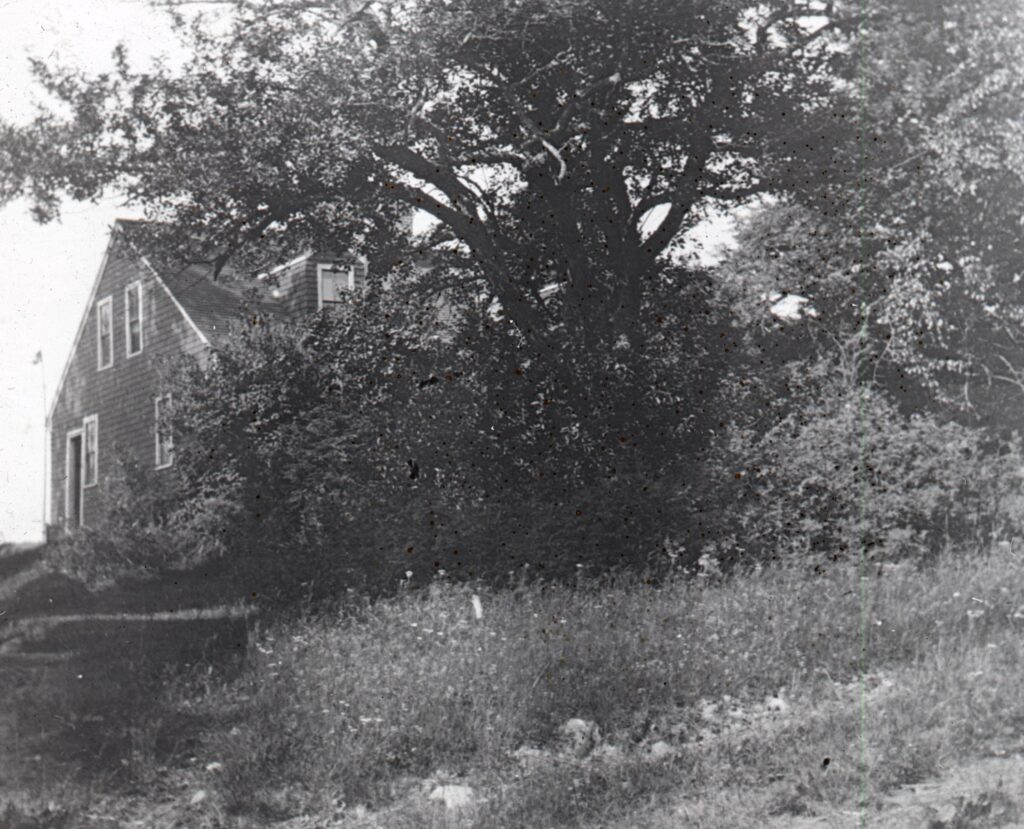
East Side of ‘The Old Patch Place’ at AMC Rhododendron Reservation -1907
Spoiler Alert: The Appalachian Mountain Club was not a conservation organization when it began. Exploration of mountains, recreation, and the pursuit of natural science knowledge were its primary goals. One would think that a group that is renowned for pushing the passage of legislation like the Weeks Act of 1911, which led the way to the creation of the White Mountain National Forest, would have conservation in its DNA. However, conservation advocacy only truly developed within AMC several years after our founding.
We might also imagine that logging was seen as a destructive force leading to the ruination of the natural beauty of the places AMC members loved best and that we were doing something about it from the start. But in the first years of AMC, logging was seen mostly as a nuisance when it encroached on trails the club had built. For example, in the 1880 Report of the Councillor of Improvements, Augustus E. Scott states that extensive logging had occurred over the winter near two trails on Mount Adams. He notes that “considerable labor was required to remove the debris and the numerous windfalls,” but makes no statements of general disapproval of logging.
Eventually, the tone of reports on logging near trails shifted to one of annoyance and avoidance. In 1885, for instance, Councillor of Improvements Isaac Y. Chubbuck advocated for the abandonment of a trail up Moosilauke from Thornton, citing “extensive lumbering operations in that region.” At the same time, thoughts within the club were turning toward preservation and the idea of forest reserves was gaining momentum. Rather than dodge logging operations or clear trails through the mess they made, what if we simply found a way to keep logging off the land entirely?
The club began its own New Hampshire Forestry Fund to start purchasing land in the state in 1893. At first, they hoped to buy land on Mounts Passaconaway or Chocorua. But failing this, they located an ideal tract to save while protecting one of their own cherished trails in the White Mountains. Logging was becoming a regular sight on the northern slopes of the Presidential Range where the club already had a strong foothold with trails, camps and Madison Spring Hut. Aside from a single acre of land around the hut, the club owned none of it, and their trails existed only by the kindness of property owners, including logging companies and private citizens hoping to eventually harvest the trees on the land.
When the club was notified in January 1895 that Ravine House proprietor, guide, trail and hut builder Laban M. Watson was starting to harvest on his land up the northern slopes, they arranged a purchase to spare some of the natural beauty along Snyder Brook. The AMC Council swiftly raised funds, and the deed was recorded in the Coos County Registry on June 13th. The thirty-six-acre tract began at the Boston & Maine Railroad track at the Club’s own whistlestop shed known as “Appalachia Station.” (The trailhead at this location is still known as Appalachia). The tract then wove up the gentle slope for about a half mile, covering three hundred feet on either side of the brook and containing hundreds of ancient hemlock trees, some of which first sprouted in the late-1600s. The boundaries of the preserve were posted, and the club felt the first thrill of protecting a place of natural beauty. Harvey N. Shepard, Chair of the Board of Trustees, found it “an auspicious beginning, though on a small scale, of a work which we trust will reach much larger dimensions in the near future.” The gesture of purchasing the land along Snyder Brook to protect it from logging and preserve its scenic beauty set the tone for the decades to come. Although now part of the White Mountain National Forest, you can still visit the magnificent hemlocks in the Snyder Brook Scenic Area.
Now that the club was a known landowner, new opportunities appeared. The next was in Shelburne, where Boston sculptor and poet Anne Whitney owned a farm. Although she was a figurative sculptor, Whitney had a passion for the landscape and appreciated the beautiful views to be had in her summer haven. She wrote that she knew of “no view in New Hampshire or elsewhere that surpasses in combined beauty and grandeur that from the Lead Mine Bridge in Shelburne.” However, the river was a useful power source, and a mill and worker housing had been built on the shore some decades before, marring the view upriver toward the Northern Presidential Peaks. To restore its scenic charm, Whitney purchased the buildings and twelve acres around them, had the structures removed, and turned the property over to AMC in February 1897. Today it is part of the White Mountain National Forest.
The donation of Lead Mine Bridge Reservation, as it was known, set off a decade of land gifts. The largest in this first rush was that of Sarah Bryant Fay in the towns of Lincoln and Woodstock. In the autumn of 1898, Fay gave about 160 acres along the Pemigewasset River to the club in memory of her father. Dubbed the Joseph Story Fay Reservation, AMC built trails and bridges, cleared blowdowns and promoted it as a local forest retreat. More land was added over the years until it exceeded two hundred acres. In 1933, AMC turned the property over to the State of New Hampshire and it was renamed Fay State Forest.
One of the next real estate donations was small but consisted of more than just land. In October 1901, Hattie A. Knight Farrar of Boston offered the club four acres with a house, barn and spring on the south shoulder of Pack Monadnock in Temple. Having a tiny outpost property in southern New Hampshire turned out to be unsustainable. The club could not find a tenant to act as caretaker or keep up with repairs. The roof leaked. At one point, someone posted a notice of occupation on the place; not having consulted the club at all. Seven years later the club arranged with Farrar to exchange the property for another adjacent tract with no buildings, although this was eventually turned over to the state as part of Miller State Park.
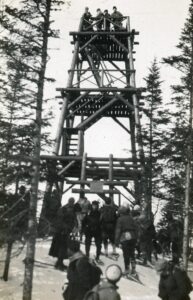
Snowshoers visiting the tower at the Walter Rockwood Davis Reservation on Black Mountain, Jackson, NH, 1914 – AMC archives
The club was accruing many small properties scattered far and wide around New England in this period. There was a concentration of them in the White Mountains, but this did not help much with the burden of maintaining all of them. In 1902, Carolin E. Clay donated two plots of ten acres each on top of South Baldface Mountain and Kearsarge North. The Kearsarge tract came with a small “refuge house,” a remnant of a former hotel. The house, and the summit general, were described as in “a most squalid and disgusting state, as a result of the untidiness of picknickers.” AMC hoped to clean the place up and hire an onsite caretaker, though this never panned out. The South Baldface tract consisted of ten acres on the summit and was devoid of any infrastructure other than trails. It was unfortunately marred by a disastrous fire soon after the acquisition. Although the region between it and the Carter Range was scorched, it still boasted one of the best views of the Presidential Range, Chocorua and the mountains of western Maine. Both tracts were eventually absorbed by the White Mountain National Forest.
To add even more to the club’s plate, in the autumn of 1902 yet another property was scouted for preservation. A large stand of native rhododendrons in Fitzwilliam was under threat by logging operations. Botany enthusiast, sponsor of Harvard’s Ware Collection of Blaschka Glass Models of Plants, farmer and Rindge native Mary Lee Ware bought the property and deeded it to AMC on April 1, 1903. It included a farmhouse, forests and rhododendron stand totaling 300 acres, the largest property yet in the club’s portfolio. The twelve-acre rhododendron swamp was designated as a public reservation to be protected in perpetuity. After several decades of renting out the cottage, the property was turned over to the N.H. Division of Parks and Recreation in 1946 as the system’s only designated botanical park. You’ll still find the rhododendrons blooming here (Rhododendron State Park) every summer.
Two more properties came our way in the early 20th century. One was a hundred-acre tract known as Sky Pond Reservation in New Hampton, given to the club in 1910. The other was the Walter Rockwood Davis Reservation on Black Mountain in Jackson, which came along in 1913. As with all the properties discussed above, these two were turned over the State of New Hampshire and the U.S. Forest Service, respectively. However, at the height of its 20th century land ownership, the club held over 750 acres in New Hampshire (plus many more tracts in other New England States). Although this pales in comparison to the over 114,000 acres we currently manage in Maine alone, AMC was a pioneer in protecting forested landscapes in New England from overuse and development.
Have you visited all these former AMC land conservation projects in New Hampshire? Did you know their stories and past connections to AMC? Visit again with fresh eyes and celebrate a piece of our conservation history.
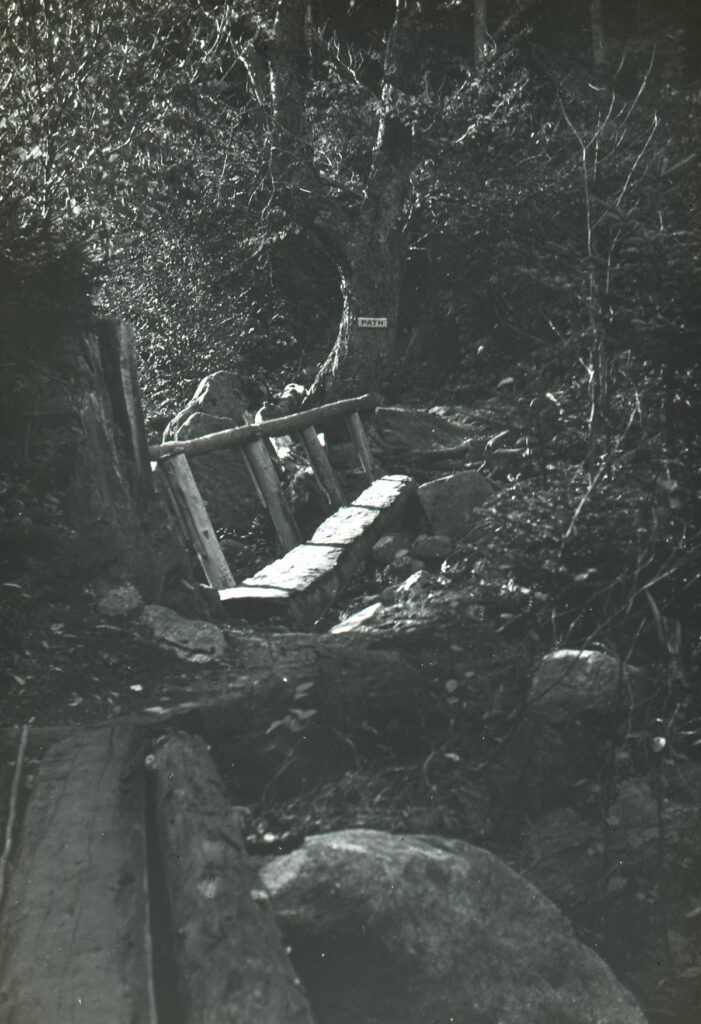
Footbridge and trail sign on the Valley Way through Snyder Brook Reservation – 1918 – AMC archives
Chapter 1: Before the Beginning
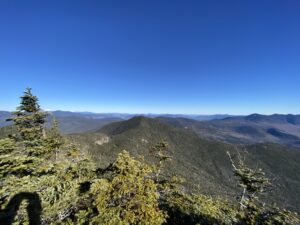
View from Mt. Osceola
On a summer’s day in 1873, a trio of men stood on the summit of Mount Osceola, high above Waterville Valley in New Hampshire’s White Mountains. From this lofty vantage point, they could see the nearby Sandwich Range, the distinctive outline of Mount Carrigain, and the densely forested expanse of the Pemigewasset Wilderness. If the day was very clear, they could have seen the Presidential Range to the north, Lake Winnipesaukee to the south, and peaks of the Green Mountains to the west. A guidebook published that year claimed that on exceptionally crystalline days, one could see the Atlantic Ocean. The three had ascended the peak by way of a rough path from Waterville, possibly having stayed the night at the Greeley House, the valley’s only hotel in an area that attracted considerable summer tourist traffic.
How many of those annual tourists cared to climb mountains on foot is unknown, but at the time these men were in the minority. Two of the party, Edward Charles Pickering, age 27, and his teenage brother William, were experiencing their first summer in the White Mountains. They eschewed typical pursuits like carriage rides to scenic vistas, gentle walks on forest paths, and picnics beside bubbling streams. Arriving from Cambridge, Massachusetts, they were taking part in a city-dweller’s typical summer stay in the clean mountain air. However, they were there to explore the land on foot, fortunate to have found a willing accomplice in retired U.S. Army quartermaster and civil engineer Colonel Charles William Folsom. As they rested on the summit of Osceola that day, we can imagine Edward marveling at the thought of climbing all those mountains and wondering if others might hold the same interest in hiking and exploration. Though he did not know it yet, he was already building the community that would help him answer that question, and it would lead to the formation of America’s oldest outdoor recreation club.
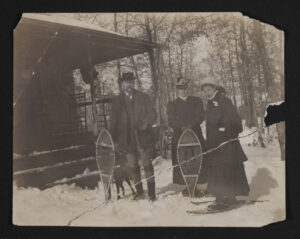
Edward Charles Pickering
During Pickering’s climb up Mount Osceola there was talk of a society of sorts. Decades later William would recall a conversation the party had on that day about forming a club. That summer Pickering ascended several peaks both with trails and those presumed to be without. The few established trails that existed would have been rough, with smaller, inconvenient trees cut out of the way and the occasional blaze made by chipping off a section of tree bark with an axe to expose the lighter wood of the tree beneath. He often found himself hiking “one of those many summits said to be unclimbed and inaccessible … only to find them frequently visited and presenting no difficulty.” This was likely indicated by well-worn bushwhack routes, summit vegetation cleared by an industrious hiker or signs of frequent camping. Pickering saw this as a sure sign that others not only wished to climb the area’s peaks but also wanted to open new areas to exploration. He made the acquaintance of other recreationists in the mountains that season as well as seeking them out upon his return to Boston and Cambridge.
In fact, he ‘discovered’ a few of these fellow hikers not by meeting them in person but by spotting them in “Summit Registers.” Just as tourists used hotel guestbooks to announce their presence, hikers found a way to note their trips in the wild where no guestbook or front desks were to be found. Starting around the 1850s, hikers began to leave Summit Registers on or near White Mountain peaks. They consisted of small, rolled notebooks tightly sealed in jars, bottles or metal containers placed among the rocks of a cairn. It was through one such register on the summit of Mount Adams that Pickering met William Gray Nowell, another early advocate of forming something like AMC.
Over the next few summers, Pickering became part of the budding recreationist community of the White Mountains. By the summer of 1875 he was out hiking with several people who would be critical to the launch and success of AMC. Civil engineer John B. Henck, Jr., soon to be the club’s first secretary, in a letter to Appalachia journal on the club’s twenty-fifth anniversary, recalled that it was while “standing upon the summit of one of those mountains, I think Mt. Attitash, with Professor E.C. Pickering, that the first conversation on the desirability and feasibility of such a club took place between us.”
Pickering let the club idea percolate as he focused on teaching, getting married, and setting up the very first physics teaching lab in the United States. Even when he did find time to formalize an outdoor organization, his life was incredibly full. The year AMC formed, not only was he a working professor at MIT but treasurer of the Boston Society of Natural History and recording secretary of the American Academy of Arts and Sciences. In October 1876, he was elected the new director of the Harvard College Observatory. He officially took up his post on February 1, 1877, and would spend the next forty-two years making it one of the most respected observatories in the world.
Nonetheless, once Pickering had been bitten by the hiking and exploration bug, the genesis of a new club around that idea seemed almost inevitable. In the summer of 1875 Pickering stayed in the same lodgings as John B. Henck, where they “brought the plans of a Club into more definite shape.” At the end of that year, they rallied their White Mountain and local outdoor enthusiast friends to come together. About fifty postcards dated Jan. 1st, 1876, were printed and mailed to men who they saw as kindred spirits, stating:
“DEAR Sir,
You are hereby invited with your friends to attend a meeting of those interested in mountain exploration to be held at the Institute of Technology on Saturday, January 8th, at 3 P.M.
Yours truly,
E.C. PICKERING”
To be continued…
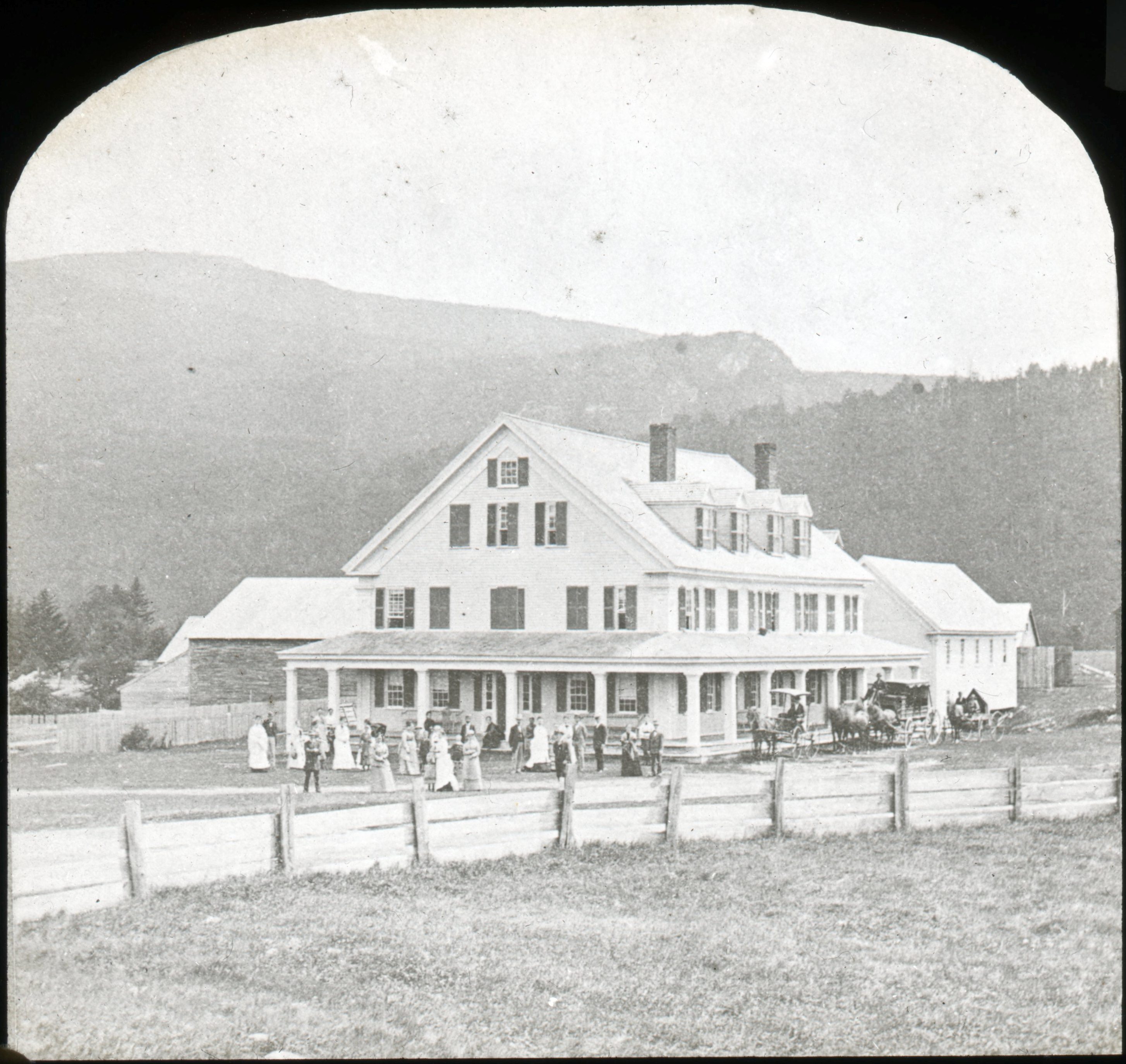
The AMC Library & Archives hold thousands of photos spanning and chronicling 150 years of club history. The Lary House photo seen here is the oldest image of club members in the collection, dating from our founding year. The White mountains and neighboring Adirondacks were only just starting to attract interest as a leisure destination, a product of a nascent affluent class in the America. You can access the digitized portion of the collection (which is always growing!) at outdoors.catalogaccess.com.